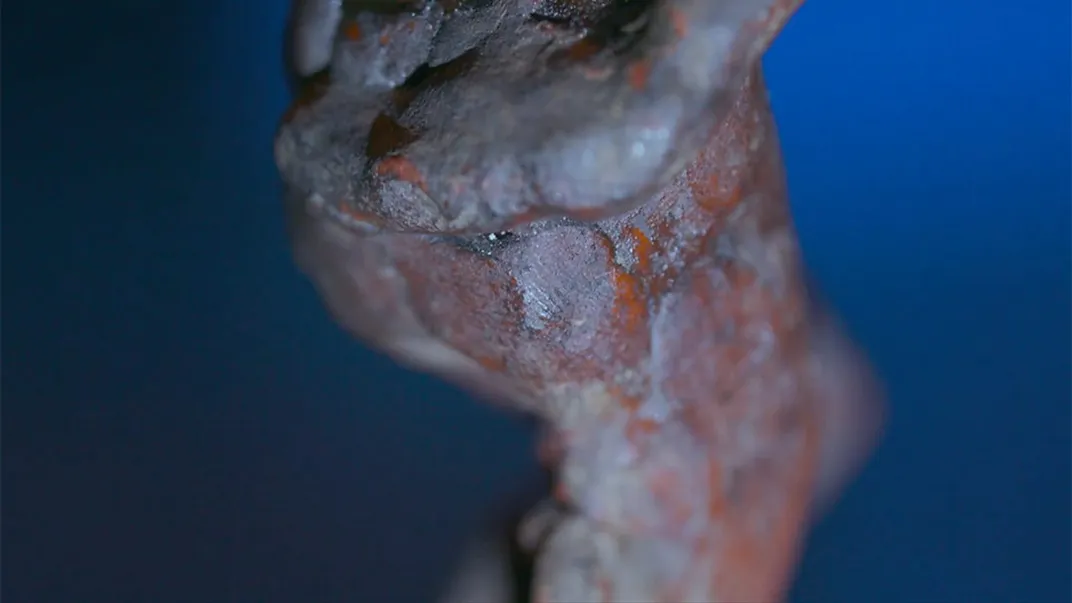Fingerprint Found on Renaissance Wax Sculpture May Belong to Michelangelo
Conservators at the V&A in London say fluctuating temperatures, humidity in storage likely revealed the long-hidden imprint
:focal(714x159:715x160)/https://tf-cmsv2-smithsonianmag-media.s3.amazonaws.com/filer/9b/35/9b357c1d-2bdd-4483-8ff2-de62f674e7a3/p09p6wl2.jpeg)
Experts at the Victoria and Albert Museum (V&A) in London have uncovered what may be Michelangelo’s fingerprint on a wax sculpture attributed to the Renaissance artist.
Staff unveiled the find in the first episode of the new season of “Secrets of the Museum,” a BBC Two documentary series about the V&A. As David Sanderson reports for the London Times, conservators made the discovery after moving the statue, titled A Slave (circa 1516–19), from an upstairs gallery to colder underground storage while the museum was closed during the Covid-19 pandemic.
Speaking with the Times, senior curator Peta Motture says that wax models “start sweating and looking uncomfortable” as temperatures rise, meaning employees “get anxious” about their safety during bouts of warm weather.
She adds, “The galleries are south facing and in summer there can be sustained heat.”
When staff examined the statue after five months in storage, they spotted a tiny fingerprint on the figure’s buttocks. Scholars speculate that shifting temperatures and humidity levels sparked changes in the wax’s chemical composition, making the marking more prominent.
“It is an exciting prospect that one of Michelangelo’s prints could have survived in the wax,” says Motture in a statement. “Such marks would suggest the physical presence of the creative process of an artist. It is where mind and hand somehow come together. … A fingerprint would be a direct connection with the artist.”

Michelangelo created the figurine as a model for a larger marble sculpture commissioned for the unfinished tomb of Pope Julius II, writes Sarah Cascone for Artnet News. The artist initially planned to include 40 statues in the design.
Though Michelangelo began carving the life-size statue, he never finished the project. (The incomplete figure—one of four in his Prisoners series—is now housed at the Galleria dell’Academia in Florence.) Per a V&A blog post, the wax model offers insights on the artist’s creative process, as he destroyed most of his other preparatory wax studies.
A number of these models survived because the artist’s contemporaries—including writer and fellow artist Giorgio Vasari—collected his studies and drawings. In his Lives of the Artists, Vasari wrote that the sculptor made wax models “in the same way figures must be carved out of marble by the chisel, [with] the parts in highest relief … revealed first and then little by little the lower parts.” In some instances, notes the V&A, wax models stand as works of art in their own right.
“It was never intended to last, that’s what is quite charming and quite remarkable about it,” conservator Victoria Oakley tells the Telegraph’s Anita Singh. “The artist probably had no clue it would survive for several more centuries beyond him.”
The statue’s survival is even more impressive given that it’s already endured one harrowing incident: In 1924, a museumgoer fell and knocked the figurine down, shattering its limbs into shards, per the Telegraph. Experts painstakingly restored the piece, and it remains relatively intact a century later, though a stain has since appeared on its surface.
As the Times reports, V&A staff plan to take “a much closer look” at the fingerprint in hopes of verifying its owner—and, by extension, the wax model’s authenticity. A terracotta sculpture titled Two Wrestlers (1530) is known to bear Michelangelo’s fingerprint and could provide a point of comparison.
/https://tf-cmsv2-smithsonianmag-media.s3.amazonaws.com/accounts/headshot/Isis_Davis-Marks_thumbnail.png)
/https://tf-cmsv2-smithsonianmag-media.s3.amazonaws.com/accounts/headshot/Isis_Davis-Marks_thumbnail.png)